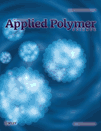Novel PDMS-based membranes: Sodium chloride and glucose permeability
Abstract
Permeation of sodium chloride and glucose through polydimethylsiloxane-poly(N-isopropylacrylamide) (PDMS-PNIPAAm) interpenetrating polymer networks (IPNs) of two different microstructures was investigated. We have successfully developed small-molecule permeable IPNs, by modifying PDMS film structure. A group of PDMS films was prepared using conventional solvent casting (SC) method and another group produced by introducing oil, followed by SC and leaching the oil out (SCOL method). Scanning electron microscopy (SEM) and attenuated total reflection fourier transformer infrared (ATR-FTIR) spectroscopy results confirmed the presence of PNIPAAm in the SC and SCOL IPNs. Results obtained from spectra of differential scanning calorimetry (DSC) showed that these IPNs had a phase transition temperature at about 32°C. Permeation measurements showed that the presence of PNIPAAm as the second phase in the IPN, improved the permeability of PDMS film. According to the results, maximum permeation coefficient was related to SCOL IPN containing 15.8% ± 0.3%PNIPAAm, at 23°C (5.98 × 10−7 ± 7.93 × 10−9 cm2/s for sodium chloride and 3.6 × 10−7 ± 7 × 10−9 cm2/s for glucose). These results suggested that these PDMS-PNIPAAm IPNs with sodium chloride and glucose permeability may be further developed as ophthalmic biomaterials or corneal replacements. © 2012 Wiley Periodicals, Inc. J. Appl. Polym. Sci., 2013




